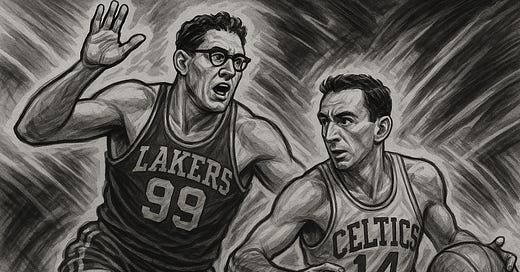Boston Celtics vs. Minneapolis Lakers
The rivalry between the Boston Celtics and the Minneapolis Lakers in the 1950s was foundational to shaping the competitive spirit of the NBA. The Lakers can be considered the first NBA dynasty before Boston claimed this distinction in the late 50s and remained dominant throughout the 60s. Both teams were stacked with Hall of Fame talent and their fiercely contested games in the late '50s highlighted the battle for basketball supremacy, laying the groundwork for future East vs. West showdowns.
Key Players
Boston Celtics
Bob Cousy: The 13-time NBA All-Star, known as the "Houdini of the Hardwood," Cousy was an innovative point guard whose playstyle revolutionized the position with his exceptional ball-handling and passing skills.
Career Averages: 18.4 PPG, 5.2 RPG, 7.5 APG
Best Statistical Season (1956-1957, MVP): 20.6 PPG, 4.8 RPG, 7.5 APG
Modern Fantasy Comparison: Ja Morant, Trae Young
· Cousy blended high scoring, high assists, and average rebounding for his position.
Bill Sharman: The 8-time NBA All-Star, sharp-shooting guard famed for his precision and scoring ability, Sharman complemented Cousy in the Celtics' backcourt, creating what some consider the greatest backcourt duo of all-time.
Career Averages: 17.8PPG, 3.9 RPG, 3.0 APG
Best Statistical Season (1955-1956, MVP – 5th): 19.9 PPG, 3.6 RPG, 4.7 APG
Modern Fantasy Comparison: Steph Curry, Damian Lillard
· Sharman was a capable scorer, posted solid assist numbers, but was not necessarily a strong rebounder.
Minneapolis Lakers
George Mikan: Mikan dominated the league during the late 1940s and early 1950s with his scoring and rebounding prowess. His presence defined the Lakers' style and success. According to Dan Barreiro of the Official NBA Encyclopedia, it is Mikan who is credited with being the NBA's first true superstar. Kareem Abdul-Jabbar echoed this sentiment in his book A Season on the Reservation writing, “He’d shown everyone that a truly big man – he was pushing seven feet – could develop agility and skills needed to play basketball… Mikan quickly opened their minds.”
Career Averages: 23.1PPG, 13.4 RPG, 2.8 APG
Best Statistical Season (1950-1951, NBA 1st Team & Scoring Champ): 28.4 PPG, 14.1 RPG, 3.1 APG
Modern Fantasy Comparison: Shaquille O’Neal
· Mikan was a league-changing center with top-tier rebounding and scoring numbers. Like O’Neal, Mikan’s presence on both offense and defense was felt near the basket. On offense, Mikan’s favorite shot was the hook shot, which he was able to shoot with either hand. On defense, Mikan’s dominance led to the NCAA instituting a “no goaltending” rule in 1944 and the NBA widened the lane from 6 feet to 12 feet in 1951 to make it harder for Mikan to dominate the game. This became known as “the Mikan rule.” Although he didn’t invent it, he was instrumental in the addition of the 3-point shot when he implemented the rule while serving as commissioner of the ABA from 1967-1969. The ABA is credited with popularizing the 3-point shot and merged with the NBA in 1976. Just three years later in 1979, the NBA instituted the 3-point shot for the first time.
Dynamics and Competitive Nature
The rivalry between the Celtics and Lakers in this era was intense primarily due to their status as the premier teams during the league's formative years. Although the Celtics were yet to become the dynasty of the 1960s, they were building their foundation under coach Red Auerbach, who was laying the groundwork for the team's future success.
Meanwhile, the Lakers were the dominant team of the early NBA, having won championships in 1949, 1950, 1952, 1953, and 1954. Their repeated runs to the championship were marked by robust performances and strategic superiority, spearheaded by Mikan's dominance in the post.
Notable Encounters
While their head-to-head clashes were significant at the time, it was the broader context of team evolution and the emergent strategies that defined their rivalry in the 1950s. Key encounters set the stage for what later became a signature rivalry once the Lakers had moved to Los Angeles and the Celtics rose to power in the late 1950s. Following the 1957-1958 season, the Lakers held a 36-28 head-to-head advantage over the Celtics. From there, the Celtics simply dominated, winning 26 of the next 27 matchups over the next three seasons. It’s no coincidence that this shift in power occurred shortly after Bill Russell joined the Celtics late in the 1956-1957 NBA season. More on Russell in next week’s article.
Championship Battles
Though these teams frequently crossed paths, it was the style of play and emerging stars on each team that helped define their friction. The Celtics were rising rapidly, bolstered by their strategic planning, which would later lead to their dynasty era. Their first NBA Finals matchup would come in 1959 when the Celtics, led by Hall of Fame head coach Red Auerbach, made quick work of the Lakers and their own Hall of Fame coach John Kundla, in a 4-0 sweep. Although the games were competitive, the Celtics victory would be the first of an incredible eight straight NBA championships.
Legacy and Influence
The Celtics vs. Lakers rivalry in the 1950s didn't possess the same intensity or frequency of their confrontations seen in subsequent decades. However, these interactions were pivotal, setting a foundational tone for future rivalries. It showcased the contrasting philosophies and emerging tactics that would come to define NBA basketball.
This rivalry is significant as the precursor to the legendary Celtics-Lakers showdowns that would dominate future decades, establishing a historical storyline that basketball fans continue to cherish. The early battles between Boston and Minneapolis helped solidify the competitive nature of the league, a vital step in growing the sport's popularity and competitive framework.
John Fritz - Bleav in Fantasy
Follow on👉Substack
👉LEAVE US A REVIEW ON APPLE PODCASTS
👉SUBSCRIBE TO OUR YOUTUBE CHANNEL
Robbin Marx
NBA Fantasy Analyst
Experience: NBC Sports - Rotoworld, HashTag Basketball, Bleav Network





